Certified Laser Safety Panels

- CE Certified Laser Safety Panels For Enclosures
- Compatible With Thorlabs Optical Enclosures
- Available in 3 Colors and 6 Sizes
LW1P1
Light Green Laser Safety Panel
50% Visible Light Transmission
LW2P1
Amber Laser Safety Panel
17% Visible Light Transmission
LW3P1
Orange Laser Safety Panel
41% Visible Light Transmission

Please Wait
| Part Number | Panel Size | Compatibilitya |
|---|---|---|
| LWxP1 | 15.44" x 12.19" | 15" x 12" Face of Enclosures |
| LWxP2 | 21.44" x 12.19" | 21" x 12" Face of Enclosures |
| LWxP3 | 21.44" x 15.44" | 21" x 15" Face of Enclosures |
| LWxP1/M | 385.8 mm x 304.8 mm | 375 mm x 300 mm Face of Enclosures |
| LWxP2/M | 535.0 mm x 304.8 mm | 525 mm x 300 mm Face of Enclosures |
| LWxP3/M | 535.0 mm x 385.8 mm | 525 mm x 375 mm Face of Enclosures |
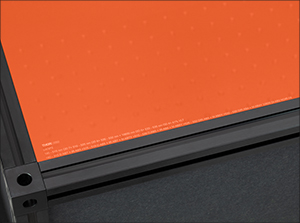
Click to Enlarge
Each laser panel is printed with its part number and laser safety specifications in the bottom left corner. These remain legible even when installed in an enclosure, like the LW3P3 panel installed in the top of an XE25C9 enclosure shown here.
Features
- Absorptive Acrylic Panels
- Protection Lasts for a Minimum of 10 seconds at Maximum EN 207 Rated Exposure (See Specs Tutorial Tab)
- Specifications Printed in the Bottom Left Corner of Each Panel
- 0.13" (3.2 mm) Thickness (LW1Px) and 0.15" (3.7 mm) Thickness (LW2Px and LW3Px)
Thorlabs' Laser Safety Panels provide CE certified laser radiation protection. The panels are made from absorptive acrylic, which provides superior resistance to breakage and prevents minor scratches from affecting laser protection. The sizes are chosen to be directly compatible with Thorlabs' line of Optical Enclosures, replacing the included panels, allowing for direct visibility into experiments while maintaining safety.
The panels come with an opaque protective film on both sides that should be removed prior to installation. The optical density (OD) and LB-Rating for specific wavelength ranges are indelibly printed in the bottom left corner of each panel for permanent identification without blocking the field of view through the panel.
Each panel includes (8) 1" long rubber vibration dampeners to increase durability and stability, eliminating rattling when the enclosure is moved.
Picking the Appropriate Laser Safety Panels
Since the correct choice of laser safety equipment depends upon many local factors that cannot be evaluated remotely, including the beam path, laser parameters, and lab environment, Thorlabs cannot recommend specific protective equipment for your application. We would recommend discussing your needs with your organization's laser safety officer.
OD to % Transmission Conversions
| OD | Transmission | OD | Transmission |
|---|---|---|---|
| 0.0 | 100% | 5.0 | 0.001% |
| 1.0 | 10% | 6.0 | 0.0001% |
| 2.0 | 1% | 7.0 | 0.00001% |
| 3.0 | 0.1% | 8.0 | 0.000001% |
| 4.0 | 0.01% | 9.0 | 0.0000001% |


OD = Optical Density
T = Transmission (decimal)
These laser safety panels are designed to directly replace the included panels in Thorlabs enclosures. Use the tables below to choose the correct panel size for your enclosure.
| Enclosure Part Number | Enclosure Sizea (L x W x H) |
LWxP1 (15.44" x 12.19") |
LWxP2 (21.44" x 12.19") |
LWxP3 (21.44" x 15.44") |
|---|---|---|---|---|
| XE25C9D | 21" x 15" x 12" | Sides | Front/Back | Top |
| XE25C10D | 21" x 15" x 12" | Sides | Front/Back | Top |
| XE25C11T | 21" x 15" x 12" | Sides | Backb | -b |
| XE25C11D | 21" x 15" x 12" | Sides | Backb | -b |
| XE25C7 | 15" x 9" x 12" | Front/Back | - | - |
| XE25C8 | 21" x 9" x 12" | - | Front/Back | - |
| XE25C9 | 21" x 15" x 12" | Sides | Front/Back | Top |
| XE25C10 | 21" x 15" x 12" | Sides | Front/Back | Top |
| XE25C11 | 21" x 15" x 12" | Sides | Front/Back | Top |

Click to Enlarge
Laser safety panels can be fit in place of the top, front, back, and side panels of Thorlabs enclosures.
| Enclosure Part Number | Enclosure Sizea (L x W x H) |
LWxP1/M (385.8 mm x 304.8 mm) |
LWxP2/M (535.0 mm x 304.8 mm) |
LWxP3/M (535.0 mm x 385.8 mm) |
|---|---|---|---|---|
| XE25C9D/M | 525 mm x 375 mm x 300 mm | Sides | Front/Back | Top |
| XE25C10D/M | 525 mm x 375 mm x 300 mm | Sides | Front/Back | Top |
| XE25C11T/M | 525 mm x 375 mm x 300 mm | Sides | Backb | -b |
| XE25C11D/M | 525 mm x 375 mm x 300 mm | Sides | Backb | -b |
| XE25C7/M | 375 mm x 225 mm x 300 mm | Front/Back | - | - |
| XE25C8/M | 525 mm x 375 mm x 300 mm | - | Front/Back | - |
| XE25C9/M | 525 mm x 375 mm x 300 mm | Sides | Front/Back | Top |
| XE25C10/M | 525 mm x 375 mm x 300 mm | Sides | Front/Back | Top |
| XE25C11/M | 525 mm x 375 mm x 300 mm | Sides | Front/Back | Top |
*** This guide is not intended as a substitute for reading and understanding the ANSI Z136 or EN 207 or EN 208 Laser Safety Standards. It is only meant to provide an introductory overview to understanding the markings on the laser panels. ***
ANSI Z136 and EN 207 Standards
Indelibly printed on the laser safety panels are two sets of numbers: Optical Density (OD) and LB-Rating, which are both used to indicate the level of protection provided for specific wavelength ranges. The OD numbers indelibly printed on the laser safety panels can be used to determine if the panels meet the ANSI Z136 standards of laser safety protection for a given laser product. In addition, the OD can be used to calculate the transmission (T) of light through the laser safety panels.

The European EN 207 standard requires that the protective filters be labeled with the CE mark and that the LB-Rating specifications are indelibly printed. The LB-Rating is composed of 3 components: a wavelength range, a laser mode designation, and a scale number. The wavelength range engraved on the laser safety panel is given in nm and is extremely important since the level of protection is wavelength dependent. The laser mode designation is based on the duration of laser pulse emitted by the laser.
Laser Mode Designation
| Laser Mode | Engraved Symbol | Pulse Duration |
|---|---|---|
| Continuous Wave (CW) | D | >0.25 s |
| Pulsed Mode | I | >1 µs - 0.25 s |
| Giant Pulsed Mode | R | 1 ns - 1 µs |
| Mode Locked | M | < 1ns |
| Please refer to the official EN 207 standard that can be purchased from BSI. | ||
The scale number (LBn) is intended to be used in conjunction with the wavelength range and the laser mode designation in order to determine if the laser safety panel meets the minimum required level of protection for a given laser; see the table below. If one component of the LB-Rating is shared, a plus sign is used to separate multiple wavelength ranges or laser modes and scale numbers in order to save space. In addition, a greater than, >, sign preceding a wavelength range indicates that the mode and scale number ratings for that wavelength range are valid for wavelengths of light greater than the bottom number in the range up to and including the top number in the range. For example, if the panels were rated as 330-370 D LB2 and >370-500 D LB3 then at 370 nm the rating would be D LB2 and for all wavelengths greater than 370 nm up to and including 500 nm would be rated at D LB3.
European Norm for the Selection of Laser Safety Equipment
| Wavelength Range | Laser Mode | Maximum Power Density (P) or Maximum Energy Density (E) |
Minimum Scale Number (LBn) |
|---|---|---|---|
| 180 - 315 nm | D | 1x10n-3 W/m2 (1x10n-7 W/cm2) | log10(P)+3 |
| I and R | 3x10n+1 J/m2 (3x10n-3 J/cm2) | log10(E/3)-1 | |
| M | 3x10n+10 W/m2 (3x10n+6 W/cm2) | log10(P)-10 | |
| >315 - 1400 nm | D | 1x10n+1 W/m2 (1x10n-3 W/cm2) | log10(P)-1 |
| I and R | 5x10n-3 J/m2 (5x10n-7 J/cm2) | log10(E/5)+3 | |
| M | 1.5x10n-4 J/m2 (1.5x10n-8 J/cm2) | log10(E/1.5)+4 | |
| >1400 - 1000000 nm | D | 1x10n+3 W/m2 (1x10n-1 W/cm2) | log10(P)-3 |
| I and R | 1x10n+2 J/m2 (1x10n-2 J/cm2) | log10(E)-2 | |
| M | 1x10n+11 W/m2 (1x10n+7 W/cm2) | log10(P)-11 | |
| Please refer to the official EN 207 standard that can be purchased from BSI. | |||
There are two ways to use the table above: start with the scale number and calculate the maximum safe power density or start with a power density and calculate the minimum safe scale number. This is demonstrated by the two examples below.
Example 1: The LW2P1 laser safety panels have an LB-Rating line that reads "180-315 D AB7 + IR AB3". So if the LG3 glasses are being used with a 10 µs pulsed 280 nm light source the table above can be referenced to find that, E=3x10n+1 J/m2, where in this example the scale number is AB3 so n=3. As a result, when the LG3 laser safety glasses are being used in this situation the maximum power density of the light source should not exceed 3x104 J/m2.
Example 2: A CW laser at 532 nm has a maximum power density of 2.2x104 W/m2. Using the table above, the scale number can be calculated using LBn=log10(P)-1, which results in a rounded up scale number of 4. The LW3P1 laser safety panel meets the safety specifications of the European EN 207 standard for this example.
dBm to mW Power Conversions
| dBm | mW | dBm | mW |
|---|---|---|---|
| 0.0 | 1.0000 | 10.0 | 10.0000 |
| 2.0 | 1.5849 | 20.0 | 100.0000 |
| 4.0 | 2.5119 | 30.0 | 1,000.0000 (1 W) |
| 6.0 | 3.9811 | 40.0 | 10,000.0000 (10 W) |
| 8.0 | 6.3096 | 50.0 | 100,000.0000 (100 W) |


P(mW) = Power in mW
Light Exiting a Fiber
| NA | Divergence Half Angle, Θ | Beam Area @ 25.4 mm (1") From Fiber |
|---|---|---|
| 0.10 | 5.7° | 20 mm2 |
| 0.15 | 8.6° | 46 mm2 |
| 0.20 | 11.5° | 83 mm2 |
| 0.25 | 14.4° | 133 mm2 |
| 0.30 | 17.4° | 199 mm2 |
| 0.35 | 20.4° | 280 mm2 |
| 0.40 | 23.5° | 383 mm2 |
| 0.45 | 26.7° | 512 mm2 |
| 0.50 | 30.0° | 675 mm2 |
Note: The values in this table are rounded down to provide conservative beam areas.
When working with fiber optics, light emitted directly from the endface of a fiber is diverging. Thus, the power density is decreasing as the beam spreads and the danger of damage to the eye decreases. The table to the left lists the beam area created by light exiting a fiber for fibers with numerical apertures (NA) between 0.10 and 0.50. If you know the total power emitted from the fiber, you can calculate the power density at 25.4 mm (1") from the fiber tip. This power density will allow you to determine the safe fiber-tip viewing distances.
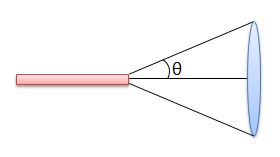
Laser Safety and Classification
Safe practices and proper usage of safety equipment should be taken into consideration when operating lasers. The eye is susceptible to injury, even from very low levels of laser light. Thorlabs offers a range of laser safety accessories that can be used to reduce the risk of accidents or injuries. Laser emission in the visible and near infrared spectral ranges has the greatest potential for retinal injury, as the cornea and lens are transparent to those wavelengths, and the lens can focus the laser energy onto the retina.
Safe Practices and Light Safety Accessories
- Laser safety eyewear must be worn whenever working with Class 3 or 4 lasers.
- Regardless of laser class, Thorlabs recommends the use of laser safety eyewear whenever working with laser beams with non-negligible powers, since metallic tools such as screwdrivers can accidentally redirect a beam.
- Laser goggles designed for specific wavelengths should be clearly available near laser setups to protect the wearer from unintentional laser reflections.
- Goggles are marked with the wavelength range over which protection is afforded and the minimum optical density within that range.
- Laser Safety Curtains and Laser Safety Fabric shield other parts of the lab from high energy lasers.
- Blackout Materials can prevent direct or reflected light from leaving the experimental setup area.
- Thorlabs' Enclosure Systems can be used to contain optical setups to isolate or minimize laser hazards.
- A fiber-pigtailed laser should always be turned off before connecting it to or disconnecting it from another fiber, especially when the laser is at power levels above 10 mW.
- All beams should be terminated at the edge of the table, and laboratory doors should be closed whenever a laser is in use.
- Do not place laser beams at eye level.
- Carry out experiments on an optical table such that all laser beams travel horizontally.
- Remove unnecessary reflective items such as reflective jewelry (e.g., rings, watches, etc.) while working near the beam path.
- Be aware that lenses and other optical devices may reflect a portion of the incident beam from the front or rear surface.
- Operate a laser at the minimum power necessary for any operation.
- If possible, reduce the output power of a laser during alignment procedures.
- Use beam shutters and filters to reduce the beam power.
- Post appropriate warning signs or labels near laser setups or rooms.
- Use a laser sign with a lightbox if operating Class 3R or 4 lasers (i.e., lasers requiring the use of a safety interlock).
- Do not use Laser Viewing Cards in place of a proper Beam Trap.
Laser Classification
Lasers are categorized into different classes according to their ability to cause eye and other damage. The International Electrotechnical Commission (IEC) is a global organization that prepares and publishes international standards for all electrical, electronic, and related technologies. The IEC document 60825-1 outlines the safety of laser products. A description of each class of laser is given below:
| Class | Description | Warning Label |
|---|---|---|
| 1 | This class of laser is safe under all conditions of normal use, including use with optical instruments for intrabeam viewing. Lasers in this class do not emit radiation at levels that may cause injury during normal operation, and therefore the maximum permissible exposure (MPE) cannot be exceeded. Class 1 lasers can also include enclosed, high-power lasers where exposure to the radiation is not possible without opening or shutting down the laser. |  |
| 1M | Class 1M lasers are safe except when used in conjunction with optical components such as telescopes and microscopes. Lasers belonging to this class emit large-diameter or divergent beams, and the MPE cannot normally be exceeded unless focusing or imaging optics are used to narrow the beam. However, if the beam is refocused, the hazard may be increased and the class may be changed accordingly. |  |
| 2 | Class 2 lasers, which are limited to 1 mW of visible continuous-wave radiation, are safe because the blink reflex will limit the exposure in the eye to 0.25 seconds. This category only applies to visible radiation (400 - 700 nm). |  |
| 2M | Because of the blink reflex, this class of laser is classified as safe as long as the beam is not viewed through optical instruments. This laser class also applies to larger-diameter or diverging laser beams. |  |
| 3R | Class 3R lasers produce visible and invisible light that is hazardous under direct and specular-reflection viewing conditions. Eye injuries may occur if you directly view the beam, especially when using optical instruments. Lasers in this class are considered safe as long as they are handled with restricted beam viewing. The MPE can be exceeded with this class of laser; however, this presents a low risk level to injury. Visible, continuous-wave lasers in this class are limited to 5 mW of output power. |  |
| 3B | Class 3B lasers are hazardous to the eye if exposed directly. Diffuse reflections are usually not harmful, but may be when using higher-power Class 3B lasers. Safe handling of devices in this class includes wearing protective eyewear where direct viewing of the laser beam may occur. Lasers of this class must be equipped with a key switch and a safety interlock; moreover, laser safety signs should be used, such that the laser cannot be used without the safety light turning on. Laser products with power output near the upper range of Class 3B may also cause skin burns. |  |
| 4 | This class of laser may cause damage to the skin, and also to the eye, even from the viewing of diffuse reflections. These hazards may also apply to indirect or non-specular reflections of the beam, even from apparently matte surfaces. Great care must be taken when handling these lasers. They also represent a fire risk, because they may ignite combustible material. Class 4 lasers must be equipped with a key switch and a safety interlock. |  |
| All class 2 lasers (and higher) must display, in addition to the corresponding sign above, this triangular warning sign. |  |
|
| Posted Comments: | |
| No Comments Posted |

| LB-Rating Specs (EN 207)a |
|---|
| 1000 - 1150 nm (D AB4 + IR AB6 + M AB6Y) |
| 1060 - 1100 nm (D AB4 + IR AB7 + M AB7Y) |
| 10600 nm (DI AB2) |
| OD Specs (ANSI Z136)a |
|---|
| 1000 - 1150 nm, OD = 5+ |
| 1060 - 1100 nm, OD = 7+ |
| 10600 nm, OD = 5+ |

| LB-Rating Specs (EN 207)a |
|---|
| 190 - 315 nm (D AB7 + IR AB3) |
| >315 - 533 nm (DIR AB5 + M AB5Y) |
| 850 - 880 nm (DIR AB4 + M AB4Y) |
| >880 - 1100 nm (D AB4 + IR AB6 + M AB6Y) |
| 10600 nm (DI AB2) |
| OD Specs (ANSI Z136)a |
|---|
| 190 - 533 nm, OD = 5+ |
| 850 - 879 nm, OD = 4+ |
| 880 - 1100 nm, OD = 5+ |
| 1064 nm, OD = 6+ |
| 10600 nm, OD = 5+ |

| LB-Rating Specs (EN 207)a |
|---|
| 190 - 315 nm (D AB7 + IR AB3) |
| >315 - 515 nm (D AB5 + IR AB7 + M AB7Y) |
| >515 - 526 nm (D AB5 + IR AB6 + M AB6Y) |
| >526 - 532 nm (DIR AB5 + M AB5Y) |
| >532 - 535 nm (DIR AB4 + M AB4Y) |
| 10600 nm (DI AB2) |
| OD Specs (ANSI Z136)a |
|---|
| 190 - 515 nm, OD = 7+ |
| 516 - 525 nm, OD = 6+ |
| 526 - 532 nm, OD = 5+ |
| 533 - 535 nm, OD = 4+ |
| 10600 nm, OD = 5+ |
 Products Home
Products Home







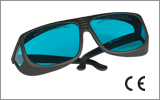
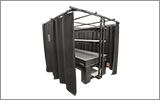
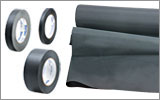

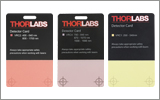
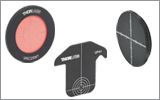
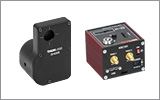
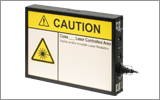


 Zoom
Zoom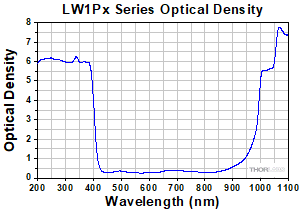

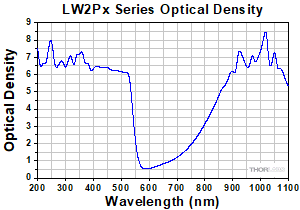

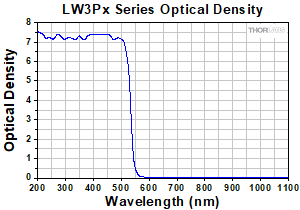
 Certified Laser Safety Panels
Certified Laser Safety Panels